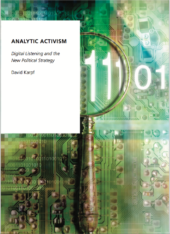Data and analytics can play a big role in improving nonprofit strategy. It usually doesn’t though, and that’s because most nonprofits are using their data wrong.
It’s time we had a little talk about strategic objects.
Think about the last strategy meeting you were a part of: What information was distributed beforehand? What charts or slides did the group focus on? What background research was critical to the conversation? What input did you wish you had, but no one had bothered to gather it in advance of the meeting? The shared materials and information that decision-makers collectively rely upon are strategic objects – the items that stakeholders orient themselves around when making strategic choices together.
Among nonprofit advocacy groups, I often witness a huge gap between the people with access to data and analytics and the people actually empowered to make strategic decisions. Usually the person with access to analytics is a low-level communications staffer or even an intern. They are charged with making the digital numbers go up, but they are never put in a position to help the broader organization listen to the data.
Put another way, if creating a strategy is like cooking a meal, then your strategic objects are the ingredients and spices in your kitchen. Data analytics could be fresh garlic.* But in practice, it’s more like the fresh, delicious ingredients that you bought at the farmer’s market, put in the fridge, then forgot about. Before you know it, you’re back to ordering takeout and wondering aloud why you keep spending so much on groceries.
Your organization can do a lot better than this. During a visit to London in 2013, I had the opportunity to stop by the national office of 38 Degrees, the UK equivalent of MoveOn.org. Their office included a large whiteboard that prominently displayed the question, “How can we increase active membership by 30%?” This was their “Testing Whiteboard.” Every week, a team of 38 Degrees staff hold a brainstorm to come up with a question vital to their mission that is worth testing. They formulate a set of rough metrics and hypotheses, spend the week running small tests, and then convene at the end of the week to summarize what they have learned. At the Monday all-staff meeting the following week, they share these lessons and discuss how it should impact the organization’s work moving forward.
The Testing Whiteboard doesn’t provide some perfect, omniscient data. (As I mentioned in my previous blog post, data is not magic.) The small experiments aren’t designed to undergo academic peer review. Some weeks, the team doesn’t learn anything particularly new or interesting. But the real power of the Testing Whiteboard, and indeed of Analytic Activism more generally, is in its role as a strategic object. 38 Degrees uses analytics and experimentation to create a culture of testing. Data and analytics have led 38 Degrees to think more clearly about what questions the organization should ask, and to arrange strategy sessions around better objects of analysis.
Analytics reports don’t replace meetings. Data doesn’t make decisions for you. But analytics can improve your meetings. Data can help you make better decisions.
Successful nonprofit strategy in the digital age isn’t going to come from hiring some “data wizard.” The big breakthroughs aren’t going to come from some fancy new psychographic profiling tool. The best digital nonprofits are the ones that bridge the gap between data and strategy. Analytics and a culture of testing can improve how your organization listens, learns, and makes decisions. But you’ll only reap these benefits if you’ve made sure key stakeholders are looped in to your digital listening practices.
* Everything is better with garlic.
Start reading Analytic Activism
from npENGAGE https://ift.tt/2pXFa8i

0 comments:
Post a Comment